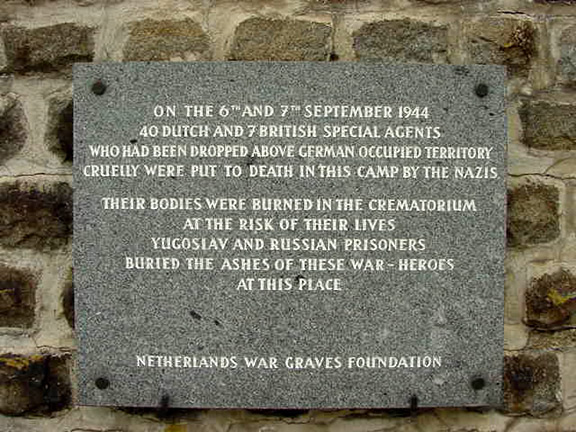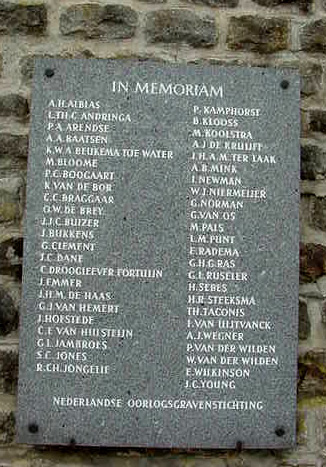Mauthausen Memorials This memorial plaque is located on the wall in the narrow space behind the bunker at Mauthausen. It is in honor of 47 British and Dutch "special agents" who had parachuted into German occupied territory and had been caught behind enemy lines, dressed in civilian clothes. According to Christian Bernadac, a prisoner at Mauthausen who wrote the book "The 186 Steps," they had first been taken to "a hard labor prison at Rawitsch." Bernadac quotes another prisoner, Hans Kanthak, who said the following in an "unpublished statement": On the 4th or 5th of September, 1944, a transport of forty-nine prisoners arrived at the concentration camp of Mauthausen. All of them came from the hard-labor prison of Rawitsch. There, a file had been opened on each of them, consisting of an individual data sheet. The prisoners of the political section were ordered to write, on each file, in red pencil, "killed while trying to escape." However, no date had been given. Upon checking the files, I noted that all these prisoners were parachutists which was not mentioned in the file, and that they had already passed several months in the hard labor prison at Rawitsch.  According to Bernadac, the forty-nine prisoners were put into the bunker, the camp prison at Mauthausen. Bernadac wrote the following: On the morning of September 6, some of these prisoners went to work with the Wienergraben work kommando. Between eight and nine o'clock in the morning there was a wild burst of gunfire, more concentrated than we had ever heard before. There were rifles, machine guns and submachine guns - all shooting at once. The bullets whistled by so fast that the prisoners and the S.S. threw themselves on the ground. [...] This wild fusillade was directed at the prisoners who had gone to work and had to carry stones. They were all mowed down. In his book "The 186 Steps," Bernadac quoted the following from the unpublished manuscript of Maurice Lampe, a French resistance fighter who was a prisoner at Mauthausen: Twenty-one corpses, frightfully mutilated, were strewn along the way. The twenty-six remaining martyrs, all more or less seriously wounded and left without care, passed another night in a prison cell and were liquidated in the same circumstances, but more quickly, the following morning. The S.S. and Kapos were doubtless "tired," or perhaps had to be rapidly available for other massacres. However, Bernadac wrote that "The next day, September 7, the second section of forty-nine prisoners went to work with the same kommando. [....] The fusillade began between eight and nine o'clock, even more impressive than on the previous day." (Bernadac gives no explanation for what happened to two of the 49 whose names are not on this memorial.) A report was filed by Hauptsturmführer Bachmayer, who was the chief of the Schutzhaftlager. In his report, according to Bernadac, Bachmayer claimed that the prisoners had tried to escape. According to Bernadac, "The men really guilty of this massacre, and of many others that had taken place, were Bachmayer and the Hauptscharführer Spatzenecker, chief of the kommando for Wienergraben work. Among the others also responsible, I only know of Kapo Zaremby, a professional criminal." Bernadac also wrote that "The inquiry was carried out by Unterscharführer Krüger, and the S.S. tribunal did not raise any objections to the procedure." The 47 Dutch and British "special agents" came under Hitler's Commando Order which was an order to execute "commandos" who parachuted behind enemy lines to commit sabotage and then surrendered with the expectation of being protected as Prisoners of War under the Geneva Convention. Regarding the nationality of the 49 men brought to Mauthausen in September 1944, Bernadac wrote that the "data sheets showed that there were Americans, Canadian and Dutch soldiers, mostly non-commissioned officers, as well as some soldiers of other nations. But there were also civilians whose professions were listed as: student, farmer, engineer, etc." The two men who were not killed, out of the 49 who arrived at Mauthausen, may have been Americans or they may have been civilians. An American commando, Lt. Jack Taylor, was also captured behind enemy lines after completing a sabotage mission, but he was not killed when he was brought to Mauthausen six weeks before the camp was liberated. Originally, British Commandos were also exempt from Hitler's Commando Order but this changed after Hitler learned that captured German soldiers had allegedly been mistreated by Candian troops. Private Memorials at MauthausenJewish MemorialsHungarian and Bulgarian MemorialsGDR (East Germany) MemorialAlbanian MemorialGeneral Karbyshev MemorialHome |